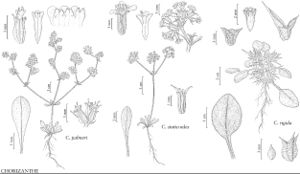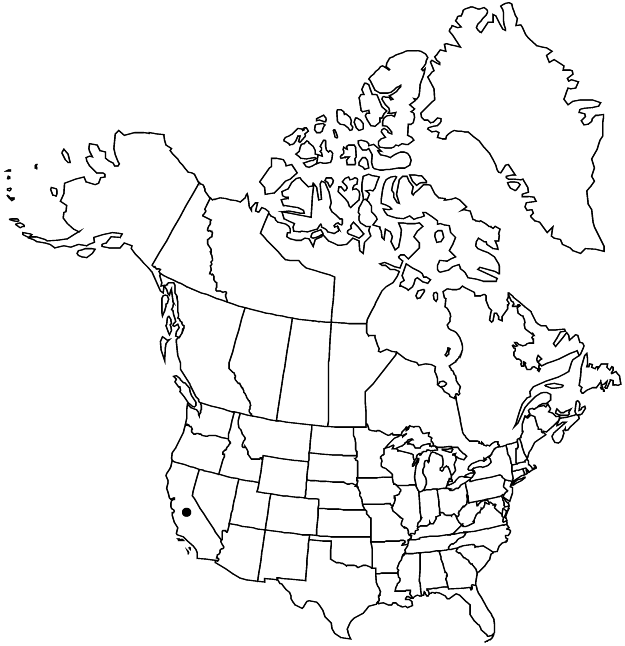Chorizanthe palmeri
Proc. Amer. Acad. Arts 12: 271. 1877.
Plants erect to spreading, (0.5–) 1–3 (–4) × 1–3 dm, appressed-pubescent. Leaves basal; petiole 1–3 cm; blade oblanceolate, 1–3 × 0.4–0.8 cm, thinly pubescent. Inflorescences with involucres in dense clusters 2–4 cm diam., greenish or reddish to purple; bracts 2–3 at proximal node, usually leaflike, often with whorl of sessile bracts about midstem, elliptic, 0.5–1.5 cm × 2–6 mm, becoming gradually lanceolate to elliptic, 0.2–1 cm × 1.5–5 mm, at distal nodes scalelike, linear and aciculate, acerose, awns straight, 1–3 mm. Involucres 3–10 or more, reddish to purplish, urceolate, slightly ventricose basally, 3.5–4 mm, without scarious or membranous margins, slightly corrugate, thinly pubescent with slender, curly hairs; teeth erect to spreading, unequal, 1–2 mm; awns uncinate, 0.5–1 mm with longer anterior one mostly 1 mm. Flowers exserted; perianth bicolored with floral-tube white to yellow and tepals red, maroon, or dark purple, cylindric, 4–5 mm, glabrous or with few scattered hairs along midrib ca. midlength; tepals erect, connate 1/2 their length, dimorphic, obovate, those of outer whorl slightly longer than inner whorl, entire, rounded apically, those of inner whorl fimbriate and truncate or somewhat 2-lobed; stamens 9, exserted; filaments distinct, 4–5 mm, glabrous; anthers pink to red or maroon, oblong, 0.9–1 mm. Achenes brown, globose-lenticular, 3–3.5 mm. 2n = 38, 40, (48).
Phenology: Flowering May–Aug.
Habitat: Gravelly to rocky serpentine and serpentinized igneous outcrops, mixed grassland communities, pine-oak woodlands
Elevation: 60-700 m
Discussion
Chorizanthe palmeri is known only from the Santa Lucia Mountains, the San Luis Range, and the Huasna area. Populations differ slightly both morphologically and ecologically, but recognition of variants is not suggested. At full anthesis, the reddish stems, involucres, and tepals, plus the localized concentrations of individuals provide for splashes of purplish red on the otherwise grass-brown slopes. Set against the often blackish green of serpentine barrens, the plants can be spotted even from a high-flying aircraft! This species would make an excellent addition to the garden border.
Selected References
None.
Lower Taxa
"/2" is not declared as a valid unit of measurement for this property."dm" is not declared as a valid unit of measurement for this property."/2" is not declared as a valid unit of measurement for this property.

